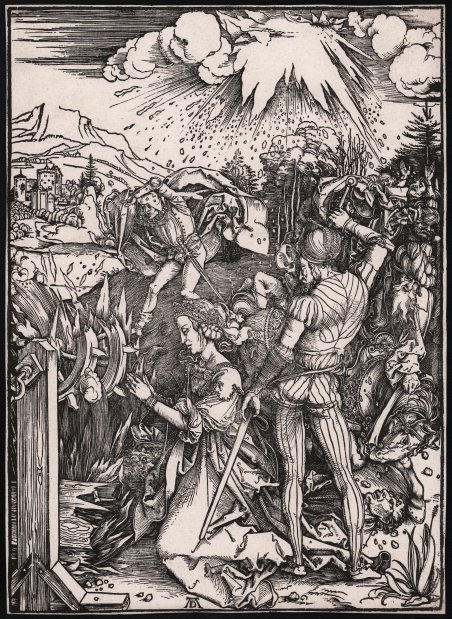Xilografia, 1498 circa, firmata con il monogramma sul blocco, in basso al centro. Esemplare della quinta variante delle sette descritte da Meder (e/g), prima delle lacune dei fori di tarlo nella schiena e nella gamba sinistra del boia. Buona impressione, stampata su carta vergata senza filigrana, piccoli margini, ottimo stato di conservazione. Secondo la Legenda Aurea di Jacobus de Voragine, Santa Caterina visse ad Alessandria d'Egitto nel IV secolo. Figlia del re Costalis di Cipro, bellissima e diciottenne, rifiutò l'ordine dell'imperatore Massenzio di rinunciare alla sua fede cristiana. Fu condannata a essere spezzata sulla ruota, ma questa crollò per ordine di Dio e una pioggia di fuoco uccise molti pagani. Qui questo evento è rappresentato insieme alla decapitazione di Santa Caterina. La xilografia conferma la funzione degli studi sul costume come materiale di fonte indipendente, poiché qui la santa appare in costume veneziano dell’epoca. Questa xilografia è strettamente legata, per stile e periodo, alla famosa serie di xilografie dell'Apocalisse di Albrecht Dürer. Lo scrittore francese proto-surrealista Alfred Jarry ammirò molto la stampa e prestò particolare attenzione al modo in cui passa dal formale alla pioggia di fuoco allucinatoria, considerandola opera che precorre il simbolismo del tardo XIX secolo. ' Il cielo infuocato e il paesaggio montuoso sono quelli di Giovanni e i ventiquattro anziani e ' Le sette trombe, entrambe tavole dell’Apocalisse, mentre il cavallo in primo piano ricorda quello dell'incisione La conversione di San Paolo. L'influenza di Mantegna si percepisce nella figura del boia. Lo sfondo ricorda La meretrice di Babilonia, sempre dell’Apocalisse. Il blocco di legno originale si trova al Metropolitan Museum of Art di New York. I versi di Dürer in lode di Santa Caterina appaiono, nel verso, sotto una xilografia del suo allievo Hans Baldung Grien. Bibliografia Meder 1932, Dürer Katalog, n. 236; Bartsch, Le Peintre graveur, VII.141.120; Dodgson 1903, 1911, Catalogue of Early German and Flemish Woodcuts in the BM, I.271.7; Schoch 2001-04, Albrecht Dürer, das druckgraphische Werk, II.128; W. Strauss, Wooodcuts and woodblocks of Albrecht Dürer, pp. 206-208, n. 57. The martyrdom of St Catherine, with St Catherine kneeling to the left facing the damaged spiked wheels; the sky has opened up and a hailstorm is hitting various people and henchmen on the ground. Woodcut, circa 1498, signed with the monogram on the block, at lower center. Example of the fifth issue of seven described by Meder (e/g), before the worm holes gaps in the executioner’s back and left leg. A good impression, printed on laid paper without watermark, small margins, very good condition. According to the Legenda Aurea by Jacobus de Voragine, St. Catherine lived in Alexandria, Egypt in the fourth century. The daughter of King Constalis of Cyprus, beautiful and 18 years old, she refused Emperor Maxentius' order to renounce her Christian faith. She was condemned to be broken on the wheel, but it collapsed at God's command and a rain of fire killed many pagans. Here this event is depicted along with the beheading of St. Catherine. The woodcut confirms the function of costume studies as independent source material, as here the saint appears in Venetian costume of the time. This woodcut is closely related in style and period to Albrecht Dürer's famous series of woodcuts of the Apocalypse. The French proto-surrealist writer Alfred Jarry greatly admired the print and paid particular attention to the way it transitions from the formal to the hallucinatory rain of fire, considering it a work that precurses the symbolism of the late 19th century. ' The fiery sky and mountainous landscape are those of John and the Twenty-four Elders and The Seven Trumpets, both plates from Apocalypse, while the horse in the foreground is reminiscent of that in the engraving The Conversion of St. Paul. Mantegna's influence is perceived in the figure of the executioner. The background recalls The Babylonian Whore, also from Apocalypse. The original woodblock is in the Metropolitan Museum of Art, New York. Dürer's verses in praise of St. Catherine appear, in the verse, under a woodcut by his pupil Hans Baldung Grien. Bibliografia Meder 1932, Dürer Katalog, n. 236; Bartsch, Le Peintre graveur, VII.141.120; Dodgson 1903, 1911, Catalogue of Early German and Flemish Woodcuts in the BM, I.271.7; Schoch 2001-04, Albrecht Dürer, das druckgraphische Werk, II.128; W. Strauss, Wooodcuts and woodblocks of Albrecht Dürer, pp. 206-208, n. 57. Cfr.

Scopri come utilizzare
Scopri come utilizzare

